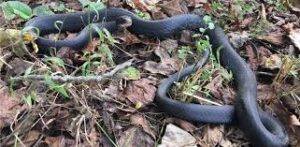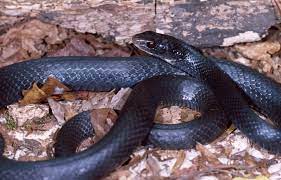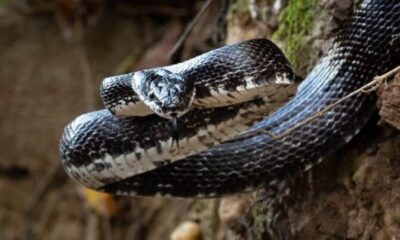The interplay between predator and prey in the natural world often presents fascinating dynamics. One such example is the relationship between black rat snakes and copperheads. As both are common snake species in certain regions, a question arises: do black rat snakes eat copperheads?
Yes, black rat snakes do eat copperheads. In fact, they are one of the few natural predators of copperhead snakes. Black rat snakes are non-venomous and have been observed preying on and consuming copperheads, making them an important part of controlling copperhead populations in certain areas.
Do black rat snakes eat copperheads?

Yes, black rat snakes do eat copperheads. Black rat snakes are non-venomous constrictors that primarily feed on rodents, birds, and other small animals. However, they are known to also prey on smaller snakes, including venomous ones like copperheads.
Black rat snakes are immune to the venom of copperheads and other pit vipers, so they are not deterred by the venom. When they encounter a copperhead, they will often attempt to constrict and consume it. This behavior can help control the population of copperheads in an area and is one reason why black rat snakes are considered beneficial to have around.
Importance of understanding the relationship between these two snake species
Understanding the relationship between black rat snakes and copperheads is important for several reasons:
- Ecological Balance: Black rat snakes play a role in maintaining ecological balance by controlling populations of rodents and venomous snakes like copperheads. By preying on copperheads, black rat snakes help keep their population in check, which can reduce the risk of copperhead bites to humans and pets.
- Natural Pest Control: Both black rat snakes and copperheads prey on rodents. Black rat snakes help control rodent populations, which can reduce damage to crops and property caused by rodents. By preying on copperheads, black rat snakes indirectly help control rodent populations by reducing competition for food.
- Conservation: Understanding the relationship between these two snake species is important for conservation efforts aimed at protecting both species. By conserving habitat for black rat snakes, we indirectly support the control of copperhead populations, which can help maintain healthy ecosystems.
- Safety: For people living in areas where copperheads are present, understanding that black rat snakes prey on copperheads can provide some reassurance. Encouraging black rat snake populations can help reduce the likelihood of encountering venomous snakes near homes and recreational areas.
So, understanding the relationship between black rat snakes and copperheads is essential for maintaining ecological balance, supporting natural pest control, conserving snake species, and promoting safety in areas where venomous snakes are present.
Black Rat Snakes: Habitat and Behavior
Black rat snakes (Pantherophis obsoletus) are non-venomous constrictor snakes native to North America. Here’s some information about their habitat and behavior:
Habitat:
- Black rat snakes are found in a variety of habitats, including forests, fields, meadows, farmlands, and suburban areas.
- They prefer habitats with plenty of cover such as rocks, logs, and dense vegetation.
- These snakes are excellent climbers and can often be found in trees, especially when young, searching for birds and eggs.
Behavior:
- Black rat snakes are primarily active during the day (diurnal) but may become more nocturnal during hot summer months.
- They are skilled hunters, preying on a variety of small animals including rodents, birds, bird eggs, lizards, frogs, and other snakes.
- Black rat snakes are powerful constrictors, squeezing their prey until it suffocates before swallowing it whole.
- During the colder months, black rat snakes hibernate in dens or burrows to survive the winter.
Reproduction:
- Mating usually occurs in the spring, shortly after emerging from hibernation.
- Females lay eggs in early summer, usually in June or July, with clutch sizes ranging from 12 to 20 eggs.
- The eggs are typically laid in a rotting log, compost pile, or other warm, moist location.
- After an incubation period of about 60 days, the hatchlings emerge.
Defense Mechanisms:
- When threatened, black rat snakes may vibrate their tails, flatten their heads, and strike, mimicking the behavior of venomous snakes like rattlesnakes.
- If threatened, they may also emit a foul-smelling musk to deter predators.
- However, their primary defense is to flee and hide rather than confront a potential threat.
Importance in Ecosystem:
- Black rat snakes play an important role in controlling populations of rodents and other small animals.
- They also help control populations of venomous snakes like copperheads by preying on them.
Understanding the habitat and behavior of black rat snakes is important for conservation efforts and for promoting coexistence with these beneficial reptiles.
Copperhead Snakes: Habitat and Behavior

Copperhead snakes (Agkistrodon contortrix) are venomous pit vipers native to North America. Here’s some information about their habitat and behavior:
Habitat:
- Copperheads are found in a variety of habitats, including forests, woodlands, rocky hillsides, swamps, marshes, and suburban areas.
- They are commonly found near water sources such as streams, ponds, and wetlands.
- Copperheads are well adapted to both terrestrial and semi-aquatic environments.
Behavior:
- Copperheads are primarily nocturnal, but they can also be active during the day, especially in cooler weather.
- They are ambush predators, lying in wait for prey to come within striking distance.
- Their diet consists primarily of small mammals, such as mice and voles, as well as birds, frogs, and insects.
- Copperheads use their heat-sensing pits to detect prey in low light conditions.
- During the winter, copperheads hibernate in dens or burrows to survive the cold temperatures.
Reproduction:
- Mating usually occurs in the spring, shortly after emerging from hibernation.
- Females give birth to live young in late summer or early fall, typically between August and October.
- Clutch sizes can range from 1 to 20 young, but 4 to 7 is most common.
- Copperheads are ovoviviparous, meaning the eggs develop and hatch inside the female’s body, and she gives birth to live young.
Defense Mechanisms:
- When threatened, copperheads may freeze and remain motionless, relying on their camouflage to blend in with their surroundings.
- If threatened, they may also vibrate their tails, similar to rattlesnakes, to warn potential predators.
- When threatened, they may also strike, delivering a venomous bite.
Importance in Ecosystem:
- Copperheads play an important role in controlling populations of small mammals and other prey species.
- They are also an important food source for many predators, including birds of prey and other snakes.
Understanding the habitat and behavior of copperhead snakes is important for conservation efforts and for promoting safety in areas where these venomous snakes are present.

